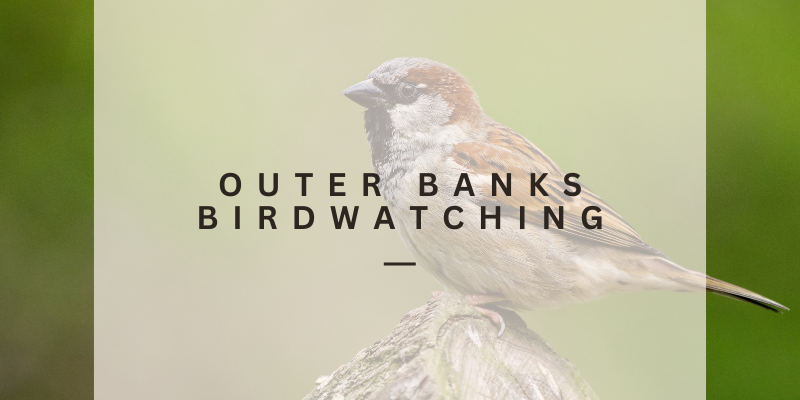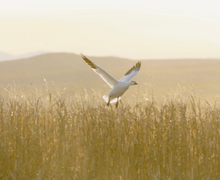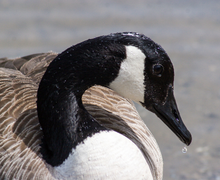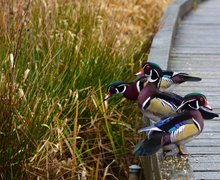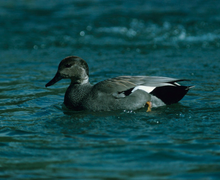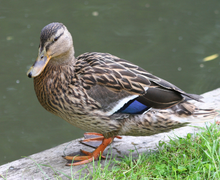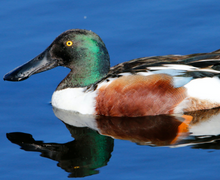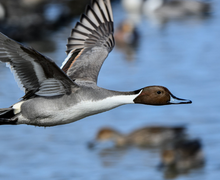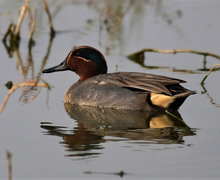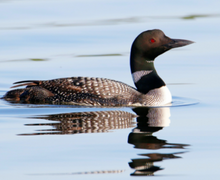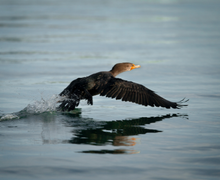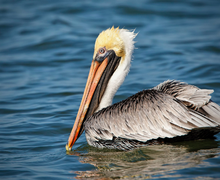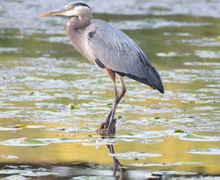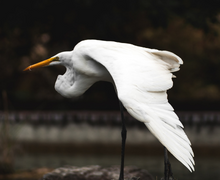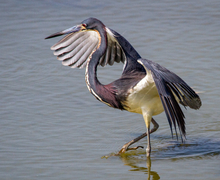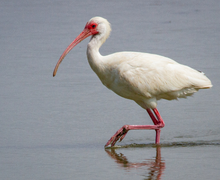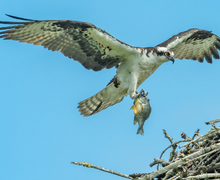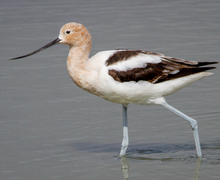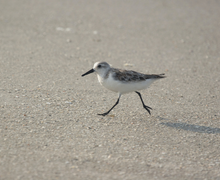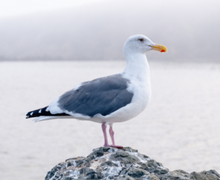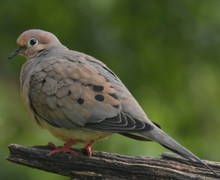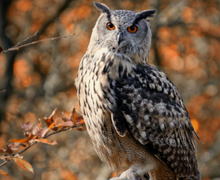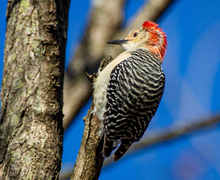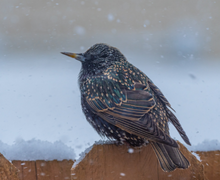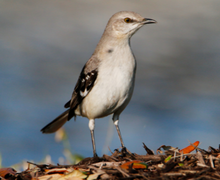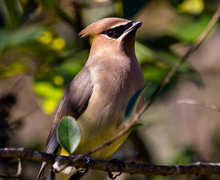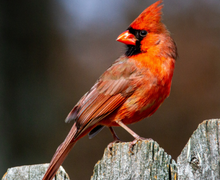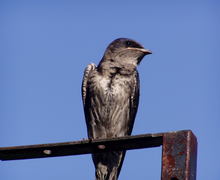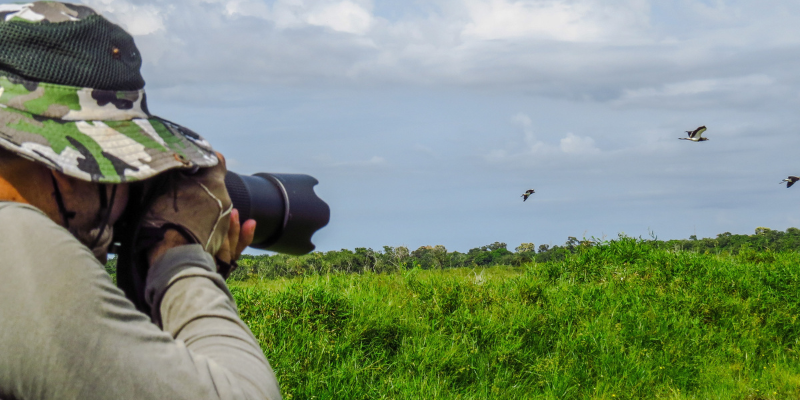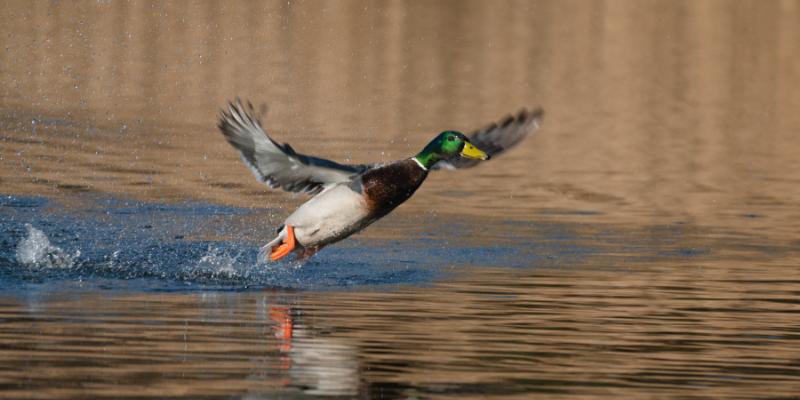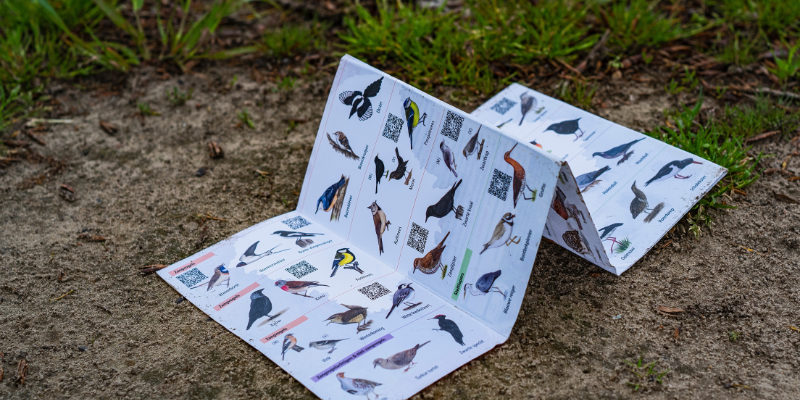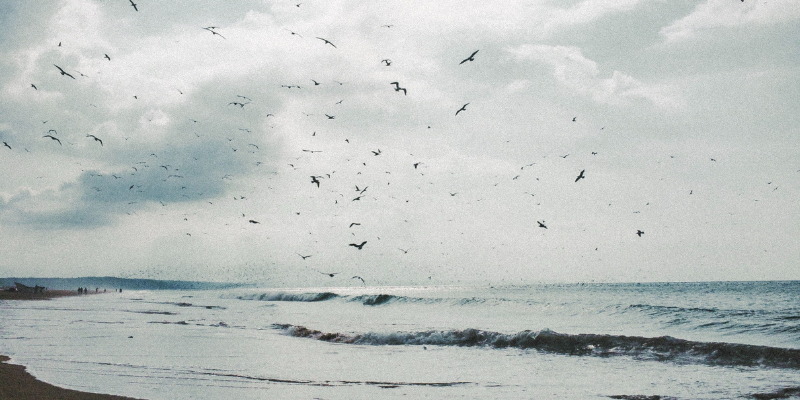Birdwatching is one of those hobbies that seem daunting at first, but can actually be a fantastic and rewarding experience that brings joy to every season of your life. It is both relaxing and exciting as you head out to enjoy the spectacular scenery while participating in a scavenger hunt for beautiful, local wildlife.
The Outer Banks, known for its beautiful beaches and delicious restaurants, is also known for being one of the best birdwatching locations in the nation. With its location near the Atlantic Ocean, the Outer Banks is an important stop on the Atlantic Flyway bird migration route, meaning that each year, thousands upon thousands of beautiful, migratory birds make their way to the Outer Banks for warmer winter travel. Keep reading for more information about the species of birds that you’ll find on the Outer Banks, the best times of year to travel to the OBX for birdwatching, and some tips and tricks for your next birdwatching adventure.
Whether you’re a novice or an expert, birdwatching on the Outer Banks is sure to be a fun and memorable experience that you should definitely try on your next Outer Banks vacation!
Outer Banks Bird Species
There are hundreds of different bird species that call the Outer Banks home throughout the year. Here is a list of some of the most common birds that you can expect to see during your Outer Banks birding adventure. For more detailed information and a more comprehensive look at the bird species native to the Eastern United States, check out The Sibley Field Guide to Birds of Eastern North America or The Shorebird Guide.
Snow Goose
The Snow Goose is a beautiful, bright white bird that migrates south for the winter months. They can usually be found around lakes and ponds and can be seen scavenging farms and other areas for food.
Canada Goose
The easily recognizable Canada Goose with a black head and neck and white chinstrap is known for its loud honking as it heads south each year for the winter. Their white, brown, and gray bodies are easy to spot in open water and you can hear them both night and day.
Wood Duck
Wood-Ducks can be found year-round on the Outer Banks and they are recognizable by their stunning plumage that sits on their heads almost like a hat or helmet. The males have bright red eyes, green and black heads, and vibrant brown, tan, and black or dark green backs. Females are a more subdued brown with blue or black details on the feathers.
Gadwall
These ducks tend to be less bright than other ducks, but their feathers are designed with intricate patterns of brown, white, and gray feathers. Their black tails set them apart from other ducks than also be found in wetland ponds.
American Black Duck
The American Black Duck looks very similar to a female mallard and is brown with a lighter-colored face and yellow beak. They are often found in salt marshes and ponds where they can be found flocking with other types of ducks.
Northern Shoveler
Northern Shovelers are distinguishable by their large, shovel-like bills that they use to scoop the sands and mud of marshes and wetlands in search of food. Male Northern Shovelers are known for their bright green heads and white and brown bodies, while the females tend to be brown and white with intricate feather designs.
Northern Pintail
These adorable ducks have intricate patterns on their wings and have long, white necks and brown heads. Their tails curve upwards, giving them a regal look as they glide along the water. The best place to see these ducks is a wildlife refuge, but they’re also known for eating grains they find on farmland during the winter.
Green-winged Teal
The Green-Winged Teal is a small duck with deep-green wing patches and a brown head. They can be found in shallow ponds, flooded fields, and marshes. While they can be found among other breeds of ducks, Green-Winged Teals are much smaller and sit high in the water.
Common Loon
The Common Loon is a migratory bird to the Outer Banks and is known for its black, white, and gray feathers and bright red eyes. Their calls can be kind of spooky but also beautiful and they are powerful divers that only come to the coast to nest, preferring the water.
Double-crested Cormorant
Double-crested Cormorants are relatively large black and brown birds with yellow-orange faces. They create quite the spectacle when sunning, usually on a dock or pile of rocks.
Brown Pelican
The Brown Pelican has an overly-large beak and can be spotted plunging into the ocean in search of fish. They are grayish-brown in color with white necks and heads and bright bills that can expand when hunting.
Great Blue Heron
Great Blue Heron are massive, easily recognizable birds with bluish-gray feathers and a black stripe across their eyes. These birds can easily be found in shorelines, river banks, and on the edges of marshes where they can easily hunt for fish. They hunt both day and night, due to special photoreceptors that give them increased night vision.
Great Egret
Found year-round on the Outer Banks, Great Egret are tall, elegant, white birds native to wetlands. They are entirely white with long necks and long, yellow beaks that they use for hunting fish. During the breeding season, their faces grow a patch of bright green skin and large plumes emerge on their backs.
Tricolored Heron
These birds can be seen on the Outer Banks year-round and tend to be bluish-gray, purple, or white in color. They are known for a long white stripe that goes down their neck, leading to a white belly. Tricolored herons are generally smaller than other herons and are commonly found in salt marshes.
White Ibis
White Ibis are migrating birds that tend to spend time in wetlands and wildlife preserves, like those found up and down the Outer Banks. They are white with black tips on their wings and have bright, red legs and curved, red beaks.
Osprey
These hawk-like birds return to the Outer Banks every spring and summer, feasting on the abundance of fish in the warm coastal waters. These large, distinctive birds look almost like eagles and are known for returning to the same nest annually. The NC Wildlife Federation usually has a live webcam of one of the regularly nesting osprey couples, so be on the lookout in the spring and early summer for this spectacular inside look!
American Avocet
These birds can be found throughout the year and are especially known for flocking to the Pea Island National Wildlife Refuge. This is actually one of the only places in North Carolina where you can see these birds and they're known for their white and black feathers with a long, thin upturned beak.
Sanderling Sandpiper
For anyone that’s seen the Disney short “Piper,” you probably know Sanderling Sandpipers as the adorable little birds that flit back and forth across the shoreline and you’re not far from the truth. These tiny white and brown burns can often be seen chasing the waves as they look for sand crabs, plucking them from the sand with adorable determination.
Herring Gull
Herring Gulls can be seen year-round on the Outer Banks and are the most familiar “seagulls” on the East Coast. These birds are gray and white with bright, yellow eyes and slightly-curved beaks.
Mourning Dove
These beautiful and easily recognizable birds are dark brown with black spots and black under their wings. You’ll be able to spot them by their rounded heads and sharp, quick movements. Their calls are long and drawn-out and when perched, they often look like big balls of fluff.
Great Horned Owl
These fascinating, intimidating birds can be found year-round on the Outer Banks. They have bright yellow eyes and tufts of feathers that look like ears on the top of their heads. Their hoot is very deep and they are a powerful predator capable of taking down animals larger than themselves.
Red-bellied Woodpecker
Red-bellied Woodpeckers are relatively common in the eastern United States and can be seen youe=round on the Outer Banks. These birds have white bellies and black and white striped wings with a red strip down the back of their head.
European Starling
European Starlings were brought to the United States during the nineteenth century and can be seen year-round on the Outer Banks and much of the United States. These short, stocky birds may seem to be dull black at first, but their feathers can actually be vibrant shades of purple, blue, and green. Other starlings may appear brown with white spots on their bellies. These birds are good at mimicking the songs of other birds and can learn the songs of up to twenty different birds.
Northern Mockingbird
Northern Mockingbirds can be spotted year-round on the Outer Banks and are known for their endless singing. These birds are white or tan with a gray or tan head and black wings with white splashes.
Cedar Waxwing
These adorable birds love fruit and tend to be brown, gray, or lemon-yellow in color. They’re recognizable by their high-pitched whistles and unique flight patterns when hunting insects. They get their name from the bright-red droplets of wax that form on the tips of their wing feathers.
Northern Cardinal
The bright, red birds are very recognizable and can be found in the eastern part of the United States year-round, including the Outer Banks. Only the male cardinals are brightly colored but even the brown and red females are easy to spot and a lot of fun to watch. Male cardinals are bright red with a black mask, bright orange beaks, and a long tail. Females are a similar shape but tend to be brown with red accents on the crest, wings, and tail.
Purple Martins
While Purple Martins aren’t necessarily the first thing to come to mind when thinking about birds to see on the Outer Banks, these famous swallows return to the William Umstead Bridge every year in droves to roost in what has become an exciting spectacle enjoyed by visitors and locals alike. Their migration to the Outer Banks begins in South America before they make their way to the northern end of Roanoke Island every summer. These birds a dark bluish/black in color, though in the sunlight they can sometimes appear purple or even green.
The Best Time of Year to Go Birdwatching on the Outer Banks
While you can easily see many different types of birds throughout the year, the winter season, from December to February, is possibly one of the best times to go birding on the Outer Banks. During these months, thousands of birds migrate to the Outer Banks. Birdwatchers can easily see mallards, northern shovelers, tundra swans, American oystercatchers, and snow geese.
Best Places to Birdwatch on the Outer Banks
If you’re looking for a great place to birdwatch in North Carolina, the NC Birding Trail offers an interactive map of wildlife refuges and preserves across the state that offer the best in birdwatching! Here are the places on the Outer Banks that are part of the NC Birding Trail, as well as some hidden gems, and are a must-see for any birdwatcher on the Outer Banks.
Mackay Island National Wildlife Refuge
Our first refuge is a little bit further north, but if you’re willing to take some time on your way down, the Mackay Island National Wildlife Refuge on Knotts Island is a fantastic place to see plenty of migratory species of birds, but especially Mallards, Teal, Gadwall, and Wood Ducks during the fall and winter. Over 187 bird species have been recorded in the refuge, including rare species like the king rail. Enjoy multiple trails in the refuge and visuals of plenty of winter waterfowl on the Currituck Sound such as Snow Goose, Northern Shoveler, and the American Wigeon.
Currituck National Wildlife Refuge
If you’d rather start your birding adventure on the main strip of the Outer Banks, check out the Currituck National Wildlife Refuge in Corolla. This refuge is made up of more than 3,000 acres of land and includes beach, dune, and maritime thicket habitats, making this a fantastic place to come to see many different types of birds and other wildlife. The best time to visit is winter to early spring when you can see Loons, Northern Gannet, Horned Grebe, and a wide variety of migrating songbirds.
Outer Banks Center for Wildlife Education
The Outer Banks Center for Wildlife Education isn’t just a great place to visit as a museum, but the surrounding grounds and boardwalk are also fantastic places to observe many different types of birds in both maritime forest and marsh habitats. During the summer, you can expect to see various Osprey nests while the winter is perfect to see warblers and migrating waterfowl.
Jockey’s Ridge State Park
Jockey’s Ridge State Park is a wonderful place to go for a hang gliding adventure or an exciting day of frolicking through the sand with the kiddos. But did you also know that Jockey’s Ridge State Park is part of the NC Birding Trail and is home to multiple habitats that are home to many different species of birds throughout the year? The thickets at the base of the dunes are a great spot for flycatchers, warblers, and sparrows while songbirds make this a regular stop during their fall migration. On the sound side, catch a glimpse of waterfowl that will be spending the winter in the temperate regions of the Outer Banks.
Nags Head Woods Ecological Preserve
Also, a wonderful place to hike, the Nags Head Woods Ecological Preserve is the perfect place to walk through a logrious maritime deciduous forest filled with over 550 species of plants and more than 150 species of birds! The preserve is home to colored prothonotary warblers, summer tanagers, and blue grosbeaks during the summer with 50 other species of birds making their nests in the forest.
Cape Hatteras National Seashore - Bodie Island
Near the Bodie Island Light Station, you’ll be able to see a wide range of shorebirds and wading birds in the marshy areas near the visitors center. Best visited during the winter, you’ll be able to see Black-necked Stilt, American Avocet, Gull-billed Tern, Least Tern, Black Skimmer, and wintering waterfowl that will make any birding trip to the Outer Banks worthwhile. Just across Hwy 12 at Coquina Beach, you’ll also be able to see loons and Northern Gannet while enjoying the peaceful nature of the southern beaches in the off-season.
Pea Island National Wildlife Refuge
Established in 1938, the Pea Island National Wildlife Refuge is a great place to visit year-round and is considered one of the best places to birdwatch in the entire state! They offer weekly birding walks (see website for details) and exciting tours and events throughout the year. With more than 5,000 acres of preserve, the Pea Island National Wildlife Refuge is home to multiple wildlife habitats including salt marsh, scrub-shrub, freshwater, and beach. Throughout the year, you can see Black Skimmer, Black-necked Stilt, and America Avocet and during the winter, expect to see thousands of snow Geese and Tundra Swan near the water. The Pea Island National Wildlife Refuge is a must for any bird-lovers trip to the Outer Banks.
Seabirding Pelagic Trips
If looking for seabirds is more your style, consider booking a Pelagic Birding Trip out of Wanches or Oregon Inlet. These 1-2 day birding trips give you the opportunity to head out onto the water and see a variety of seabirds that you wouldn’t normally be able to experience on the shore. During the winter, common bird species include the Parasitic Jaeger, the Great Skua, the Atlantic Puffin, and the Razorbill. During the summer, you can expect to see birds like the Brown Noddy, Arctic Tern, South Polar Skua, and Pomarine Jaeger. With many different available dates and group rates, this is a fantastic adventure opportunity for the passionate birder in your life.
Tips for Birdwatching
Birdwatching is definitely one of those hobbies where you are free to invest as much (or as little) as you want. While you absolutely can just step outside and look around your yard for different bird species and still get a lot of enjoyment and relaxation out of your time, there are some things that you can do to make your Outer Banks birdwatching adventure both fun and successful. Here are some of our favorite tips for birdwatching.
Birdwatch With the Sun Behind You
The best way to find exactly what you’re looking for is to make sure that the sun is to your back when birdwatching. This way, you’ll be able to better see the birds’ wings and feather colors when they’re reflected in the sunlight. Otherwise, you might just end up seeing black shapes and silhouettes, which doesn’t really lend itself to the best birdwatching experience.
Invest in Binoculars
For the more experienced birders out there, this may seem like common sense, but if you really want to enjoy your experience looking for birds on the Outer Banks, you may want to invest in a pair of binoculars that are made specifically for birdwatching. Check out this list of the 12 Best Binoculars for Birding from World Birds for some good places to start.
Have a Plan
While you can’t guarantee exactly what you’ll see on each trip, make a list of the different types of birds that you can expect to see and pick a dream list of maybe 4-5 species of birds that you’re hoping to see. This makes it easier to learn everything you can about each of those birds, which increases your chances of actually finding them.
Focus on 4 Main Traits for Bird Identification
It can be really overwhelming to figure out exactly what species of bird you’re looking at in the wild, so experienced birders usually recommend focusing on 4 main characteristics that will help you more accurately identify your subject. These characteristics are 1) Habitat, 2) Behavior, 3) Size/Shape, and 4) Color/Pattern. Honing in on these 4 things can help keep you from getting overwhelmed while still giving you the chance to make some real progress.
Be Familiar With (and Follow) Birding Ethics
Almost like the “pirate’s code” mentioned in Disney’s Pirates of the Caribbean, all birders are expected to follow an accepted set of ethical guidelines when in the field. These guidelines are more general than specific (and obviously not legally binding), but they offer important things for you to keep in mind while birdwatching. Be sure to keep your distance and be cautious around nesting birds. You can want to enjoy the wildlife, not spook or startle them. Stay as quiet as possible and leave your dogs at home. You’re not hunting the birds; you’re watching them. Lastly, stay on the designated trails to avoid damaging preserve areas and don’t use audio to try to lure a specific species to you. This won’t actually bring them to you and ends up doing more harm than good.
Wings Over Water Wildlife Festival
Every October, the Wings Over Water Wildlife Festival takes place up and down the Outer Banks. During this week-long event, volunteers and experts in the field of birdwatching and wildlife conservation host classes, events, and guided tours at one of the amazing birdwatching locations on the Outer Banks. The event is sponsored by the Coastal Wildlife Refuge Society and gives guests the opportunity to learn more about birds and other wildlife on the Outer Banks as well as enjoy group birding excursions. Don’t worry if you miss the October event, as an “Encore” is regularly held in the first weekend of December to give birdwatchers another chance to enjoy the best of the eastern region’s birdwatching community.
Book a vacation rental for your ultimate birding adventure today!
Fortunately, we have beautiful and comfortable Outer Banks vacation rental homes near many amazing spots, from Corolla all the way down to South Nags Head, which sits just a short drive from the Cape Hatteras National Seashore. Take a look at our available rentals and find the perfect beach house for your next Outer Banks birding adventure. It’s never too early to plan ahead and never too late to book that last-minute getaway. So what’s stopping you? Book your next Outer Banks vacation rental with Seaside Vacations today!
FIND THE PERFECT VACATION HOME BY CATEGORY:
- Dog-Friendly Rentals
- Oceanfront Rentals
- Rentals with a Private Pool
- New to Seaside
- Group Travel and Event Homes
- Any Day Stays
Or by City:
Explore our website and give us a call to help kick-start your unforgettable Outer Banks vacation today. Be sure to follow us on Facebook, Instagram, YouTube, Pinterest, and TikTok to stay up to date on all of our specials, new & featured homes, and tips & tricks for making the most of your next Outer Banks vacation.
We’ll see you at the beach.


